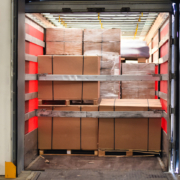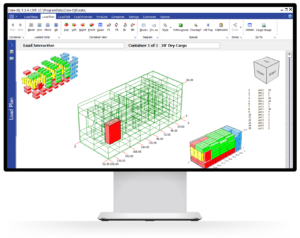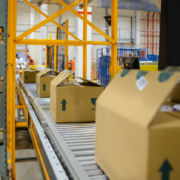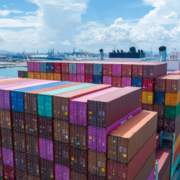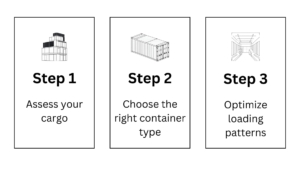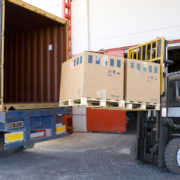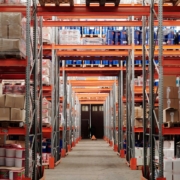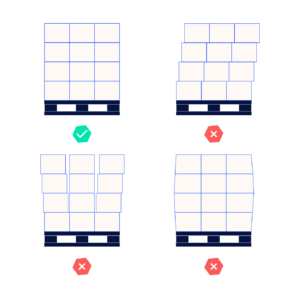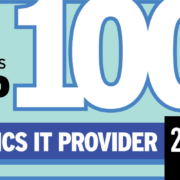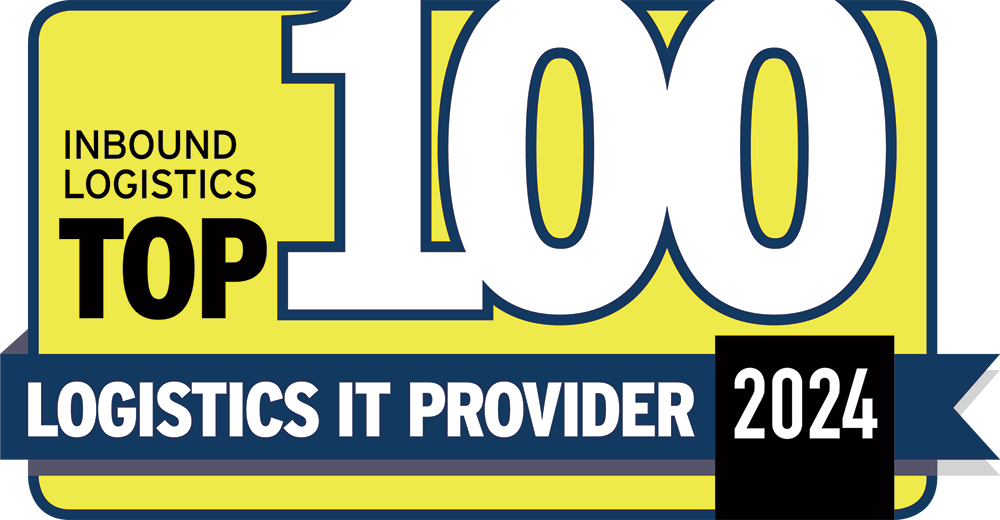What Is a Containerized Load? Types, Benefits and Challenges
Understanding containerized loads
A containerized load refers to goods packed into a standardized shipping container for transport via truck, rail, or ocean freight. These containers ship securely and simplify handling, reduce the risk of damage, and improve efficiency across the supply chain. Unlike loose cargo, containerized loads are packed according to specific weight distribution to minimize both transport costs and delays.
Containerized shipping has been around for decades, and today, most freight—whether it’s electronics, apparel, or industrial equipment—is transported in containers. However, optimizing these loads isn’t just about stacking products inside a metal box. Intelligent load planning will help you maximize space while maintaining stability, preventing damage, and meeting carrier requirements.
Types of containerized loads
Containerized loads come in various forms, depending on the shipment size, cargo type, and transportation requirements you face. And in order to choose the right shipping method, you should understand their differences.
- A full container load (FCL) fills an entire container and is a good method if you have enough goods to justify it. FCL shipments can reduce handling risks since your cargo isn’t mixed with other shippers’ goods.
- A less than container load (LCL) shipment doesn’t fill a full container and is consolidated with cargo from other shippers. LCL is cost-effective for smaller shipments, but it may involve more handling, which tends to increase the risk of damage or delays.
- Specialized containers may be required for unique cargo needs:
- Dry containers (the most common type) are used for general cargo such as electronics, clothing, and consumer goods. These containers are fully enclosed and protect your shipments from the elements.
- Refrigerated containers (reefers) are temperature-controlled containers and are used for perishable goods like food, pharmaceuticals, and chemicals that require consistent cooling or freezing.
- Flat rack containers have collapsible sides or no walls and are designed for oversized cargo like heavy machinery, vehicles, or large construction materials.
- Open-top containers have a removable roof, allowing for easy loading if you have tall or bulky items that can’t fit through standard container doors.
Each type of containerized load plays a crucial role in modern logistics, ensuring that your goods are transported securely and efficiently based on their unique handling and storage needs.
Benefits of containerization
Containerized shipping can improve your efficiency, security, and cost-effectiveness in several ways:
-
- Better use of space — Standardized containers and intelligent load planning allow for optimal packing, ensuring goods are stacked efficiently and reducing wasted space. (So you’re not paying to ship air!)
- Cost efficiency — By maximizing space and reducing manual handling, containerization will lower your transportation and labor costs. Full container loads can also help you avoid extra fees associated with less than container load consolidation.
- Enhanced security — Sealed containers protect shipments from theft, tampering, and environmental exposure. Since your goods remain enclosed from origin to destination, the risk of loss or damage due to external interference is significantly reduced.
- Improved management — Containerized shipments streamline logistics by simplifying tracking and inventory management. Standardized container sizes also make it easier for you to plan your warehouse space and transportation routes.
- Reduced damage — Containers shield your goods from weather conditions, mishandling, and external impacts. With fewer touchpoints in transit, the likelihood of damage is much lower compared to loose cargo shipments.
- Fewer errors — Automated tracking and handling systems reduce your chances of misloading, misplaced cargo, or shipping to incorrect destinations. Containerized loads improve accuracy in global supply chains.
- Environmental benefits — By improving the use of space and enabling intermodal transport (ship, rail, and truck), containerization helps you cut down on fuel consumption and emissions. A well-packed container means fewer trips, reducing your overall carbon footprint of freight transport.
The containerization process
A well-executed containerization process ensures your shipments move efficiently while maximizing space, reducing costs, and preventing damage.
- 1. Order preparation — Start by picking, packing, and labeling shipments based on their destination and shipping requirements. Choosing the right type of container—whether standard dry, refrigerated, or open-top—depends on your cargo’s size, weight, and handling needs.
- 2. Load Planning and Palletization — To make the most of your container space, you need to determine the best way to arrange your cargo. Load planning software helps you optimize cartonization and palletization, ensuring that items are packed securely, weight is distributed evenly, and available space is used efficiently.
- 3. Container Packing and Securing — Once your pallets are ready, they’re loaded into the container following best practices. Heavy items go on the bottom, fragile goods are cushioned, and dunnage (like airbags or bracing) prevents shifting. Proper packing reduces the risk of damage and helps your shipments arrive intact.
- 4. Sealing and Documentation — After packing, the container is sealed and documented for security and compliance. Accurate paperwork, including bills of lading and customs forms, helps prevent delays and ensures smooth movement through ports and checkpoints.
- 5. Shipping and Transit — Your container is then transported by truck, rail, or ocean freight. Real-time tracking gives you visibility into its location, estimated delivery times, and any potential delays. With proper load planning, you can minimize wasted space and shipping costs while keeping your supply chain moving efficiently.
- 6. Unloading and Final Delivery — Once the container arrives, it’s unloaded, and shipments are distributed to their final destinations. If needed, deconsolidation centers can break down the container’s contents into smaller shipments for last-mile delivery.
Challenges in containerized shipping
While containerization offers many benefits, it also comes with challenges that can impact your supply chain efficiency and costs.
Limited availability of containers — During peak shipping seasons or global disruptions, finding available containers can be difficult. Shortages lead to higher costs and longer wait times, making it essential to plan ahead and optimize container usage.
Regulatory and compliance considerations – Shipping across borders means navigating a complex web of customs regulations, safety standards, and environmental policies. Failure to comply with weight limits, hazardous material handling, or required documentation can lead to fines and shipment delays. Staying up to date with international regulations and using technology to automate compliance checks can help you avoid costly errors (psst, load planning software can handle that).
Even with these challenges, strategic planning and the right technology can help you navigate containerized shipping more efficiently and keep your supply chain moving smoothly.
Container freight stations (CFS)
A container freight station (CFS) is a warehouse where LCL shipments are consolidated before transport and deconsolidated upon arrival. Combining your smaller shipments with shipments from other businesses to create full container loads helps you maximize space, reduce costs, and improve efficiency in international shipping.
CFS facilities also make sure customs processing goes smoothly by providing a central location for inspections and paperwork. This will reduce your delays, lower your costs, and help keep things running smoothly.
Innovations in containerized shipping
Those who have been too busy wrangling supply chain issues to read up on containerization trends may not have noticed, but tech advancements are marching on toward efficiency, security, and cost effectiveness. Here are a few industry-shaping innovations to keep an eye on:
Automation in containerization
Automated cranes, robotic loaders, and smart sensors are transforming how containers are packed, moved, and tracked. Ports and logistics hubs increasingly rely on automation to speed up loading and unloading, reduce labor costs, and minimize human error. Have you seen these robots in the wild? Pretty sweet.
Cloud-Based Solutions for Seamless Logistics
Cloud platforms connect shippers, carriers, and logistics providers in real time, enabling better coordination and visibility across the supply chain. Integrated systems help track shipments, optimize container space, and automate compliance with international shipping regulations. Load planning software is one example of a cloud-based tool that helps businesses maximize efficiency.
Predictive Analytics in Shipping Optimization
AI-driven predictive analytics use historical and real-time data to anticipate demand, prevent bottlenecks, and optimize the use of containers. By forecasting shipping trends and potential disruptions, businesses can make smarter decisions to reduce costs and improve transit times. That’s right, AI is everywhere—and we love it!
Smart containers and IoT tracking
Have you heard of this one? Containers are now equipped with Internet of Things (IoT) sensors that provide real-time tracking, monitor temperature and humidity, and detect tampering. These smart containers help businesses reduce losses, improve security, and ensure compliance for temperature-sensitive goods like pharmaceuticals and food.
Blockchain for supply chain transparency
Blockchain technology is being used to create tamper-proof, transparent shipping records that improve documentation accuracy and reduce fraud. This is particularly useful for cross-border trade, where verifying shipment origins and tracking container movements can be complex.
Sustainable containerization
What’s next? The industry is exploring eco-friendly container materials, biofuels, and alternative energy sources to reduce carbon footprints. Some ports are even implementing fully electric cranes and automated systems to decrease emissions during container handling.
Implementing containerization with MagicLogic
Optimizing containerized shipping isn’t just about fitting goods into a box—it’s about making every inch of space count while ensuring stability, efficiency, and cost savings. MagicLogic’s advanced load planning software will help you use every inch of container space more efficiently—so you’re paying to ship your goods, not air. Whether you’re consolidating LCL shipments or planning full container loads, our intelligent algorithms ensure your cargo is packed efficiently to streamline shipping and lower your costs.
Our customizable tools are tailored to your unique shipping needs, and MagicLogic integrates seamlessly with your existing systems to automate your load planning. Your accuracy and your supply chain performance will improve. Contact us today to see how MagicLogic can transform your containerized shipping strategy.
